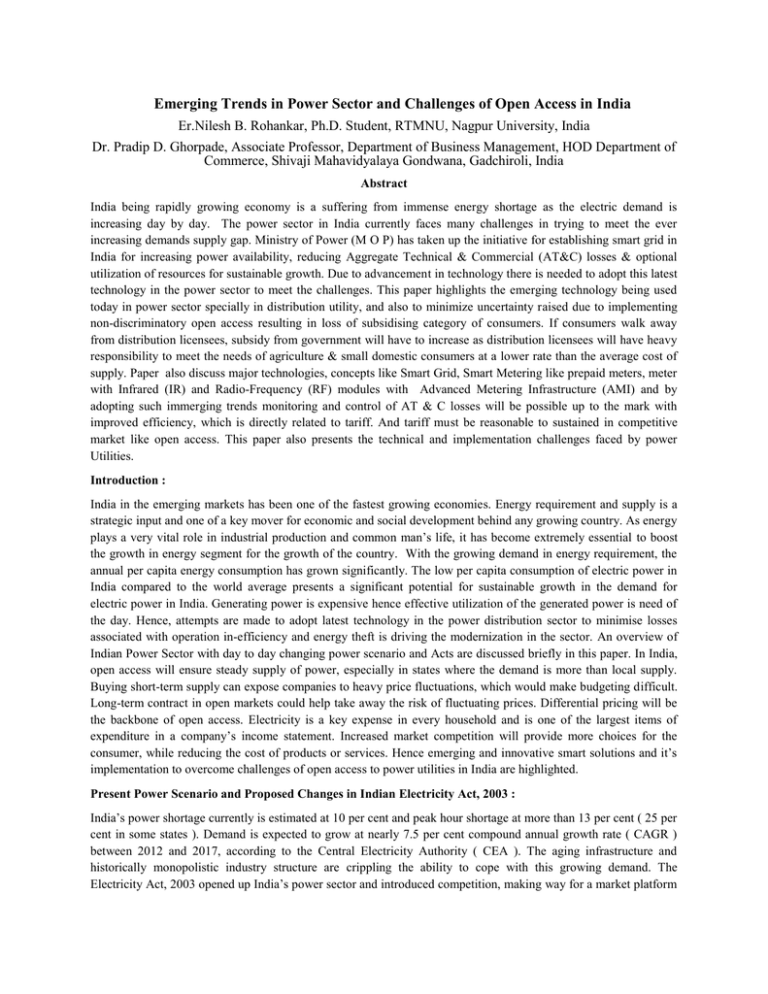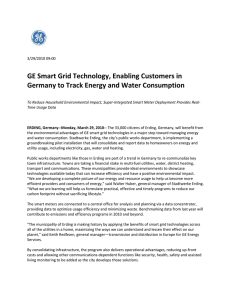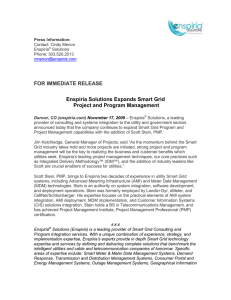Emerging Trends in Power Sector and Challenges of
advertisement

Emerging Trends in Power Sector and Challenges of Open Access in India Er.Nilesh B. Rohankar, Ph.D. Student, RTMNU, Nagpur University, India Dr. Pradip D. Ghorpade, Associate Professor, Department of Business Management, HOD Department of Commerce, Shivaji Mahavidyalaya Gondwana, Gadchiroli, India Abstract India being rapidly growing economy is a suffering from immense energy shortage as the electric demand is increasing day by day. The power sector in India currently faces many challenges in trying to meet the ever increasing demands supply gap. Ministry of Power (M O P) has taken up the initiative for establishing smart grid in India for increasing power availability, reducing Aggregate Technical & Commercial (AT&C) losses & optional utilization of resources for sustainable growth. Due to advancement in technology there is needed to adopt this latest technology in the power sector to meet the challenges. This paper highlights the emerging technology being used today in power sector specially in distribution utility, and also to minimize uncertainty raised due to implementing non-discriminatory open access resulting in loss of subsidising category of consumers. If consumers walk away from distribution licensees, subsidy from government will have to increase as distribution licensees will have heavy responsibility to meet the needs of agriculture & small domestic consumers at a lower rate than the average cost of supply. Paper also discuss major technologies, concepts like Smart Grid, Smart Metering like prepaid meters, meter with Infrared (IR) and Radio-Frequency (RF) modules with Advanced Metering Infrastructure (AMI) and by adopting such immerging trends monitoring and control of AT & C losses will be possible up to the mark with improved efficiency, which is directly related to tariff. And tariff must be reasonable to sustained in competitive market like open access. This paper also presents the technical and implementation challenges faced by power Utilities. Introduction : India in the emerging markets has been one of the fastest growing economies. Energy requirement and supply is a strategic input and one of a key mover for economic and social development behind any growing country. As energy plays a very vital role in industrial production and common man’s life, it has become extremely essential to boost the growth in energy segment for the growth of the country. With the growing demand in energy requirement, the annual per capita energy consumption has grown significantly. The low per capita consumption of electric power in India compared to the world average presents a significant potential for sustainable growth in the demand for electric power in India. Generating power is expensive hence effective utilization of the generated power is need of the day. Hence, attempts are made to adopt latest technology in the power distribution sector to minimise losses associated with operation in-efficiency and energy theft is driving the modernization in the sector. An overview of Indian Power Sector with day to day changing power scenario and Acts are discussed briefly in this paper. In India, open access will ensure steady supply of power, especially in states where the demand is more than local supply. Buying short-term supply can expose companies to heavy price fluctuations, which would make budgeting difficult. Long-term contract in open markets could help take away the risk of fluctuating prices. Differential pricing will be the backbone of open access. Electricity is a key expense in every household and is one of the largest items of expenditure in a company’s income statement. Increased market competition will provide more choices for the consumer, while reducing the cost of products or services. Hence emerging and innovative smart solutions and it’s implementation to overcome challenges of open access to power utilities in India are highlighted. Present Power Scenario and Proposed Changes in Indian Electricity Act, 2003 : India’s power shortage currently is estimated at 10 per cent and peak hour shortage at more than 13 per cent ( 25 per cent in some states ). Demand is expected to grow at nearly 7.5 per cent compound annual growth rate ( CAGR ) between 2012 and 2017, according to the Central Electricity Authority ( CEA ). The aging infrastructure and historically monopolistic industry structure are crippling the ability to cope with this growing demand. The Electricity Act, 2003 opened up India’s power sector and introduced competition, making way for a market platform allowing the customers to choose an electricity provider from the open market. A business located anywhere in India can buy power from a generator based in any state in the country. With respect to amending the Act, Ministry of Power has proposed several amendments in IEAct, 2003 mainly targeting the distribution segments. This amendments highlights separation of supply licensees from distribution licensees, tariff revision as well as Open Access. With the introduction of supply licensees, eligible consumers will be able to choose their electricity suppliers and licensees will be mandated to supply power to consumers at tariffs determined by the regulators. This will encourage open access in distribution and improve the quality of electricity supply, which is a major concern. Other changes proposed for bringing in clarity and discipline in the implantation of provisions in the act includes mandatory time-bound reduction of cross-subsidy provisions specified in the National Tariff Policy and the National Electricity Policy. Also existing distribution licensees may be responsible for power supply till the transfer of electricity supply obligations to supply licensees. The amendments also proposed that the state governments should specify a transfer scheme for separation of the distribution and supply businesses within three years of this provision coming into effect or within a time period specified by the state government with the approval of the central government. The separation would enable the presence of multiple supply licensees in a single area, which is expected to promote competition at the retail level by allowing consumers to opt for the supplier of their choice. However to resolve the issues of what obligations, responsibilities, assets and liabilities of the existing distribution licensees are taken over by successor / primary supply licensees. If the responsibility of controlling AT & C losses is transferred to the supply license, the license should be allow to undertake metering management and disconnections for nonpayment. What is OPEN ACCESS? The act defines OPEN ACCESS as – ‘’Non – Discriminatory provision for the use of transmission lines or distribution systems, or associated facilities, by any licensee or consumer or a person engaged in generation.’’ This system allows generators to sell power to the highest bidders. Consumers can, therefore, source their needs from the most economic seller. The idea is that customers should be able to choose from a large number of competing power companies instead of being forced to buy electricity from their local electric utility. 3. Smart Grid Initiatives: What is a Smart Grid? Smart grid is a power system infrastructure with an addition of Information & Communication Technology (ICT) which has potential to have a dynamic two-way digital communication at all levels of power grid–generation, transmission, distribution, and consumer. Equipped with this modernized full digital technology and smarter features to handle complex city, the traditional power system is elevated as or referred as smart grid. This two-way communication allows customers to communicate directly or indirectly with utilities on hourly or daily basis to know about relevant information. The key attributes of the envisioned smart grid enables active participation by customers, accommodates all generation and storage options, enables new products, services, and markets, provides the power quality for the range of needs in a digital economy, optimizes asset utilization and operating efficiently, anticipates and responds to system disturbance in a self-healing manner and operates resiliently against physical and cyber attacks and natural disasters. Key Drivers of the Smart Grid in India: The challenges confronting the Indian power market is to realize the objectives of reducing AT&C (aggregate technical and commercial) losses and chronic supply-demand gap, improving reliability and quality of power supply, customer satisfaction, more sustainable grid, electrification, integration of renewable energy resources and demand side management and peak load management 4. Smart Metering / Solutions and it’s necessity : Considering technical and operational constraints of power utilities by MOP ( Ministry of Power ) in implementing open access, smart solutions and it’s necessity are gaining importance in Indian market. The constraints such as installation of SEM meters ( Special Energy Meters ) by all consumers above 1 MW. Intrastate ABT ( Availability Based Tariff ) will be applicable to all open access consumers. Also capacity building of State load dispatch centers by necessary smart technologies to handle such large number of open access consumers is also to be looked into. Need for proper mechanism to insure coordination between all concern distribution licensees, State transmission utility open access consumers, generators, load dispatch centers at various levels etc., Smart solution will play a vital role. In the same manner issues like connectivity with SLDC, nature of usage of open access consumers whether captive or not, futures trades related to Power exchange, limitations in Over drawl, Communication infrastructure ( SCADA ), Scheduling, Commercial settlements and switching by consumers during off peak hours to power exchange etc. and return back to distribution licensees are major concern & will be resolved by smart solutions. 5. Advanced Metering Infrastructure (AMI) AMI system comprises smart meters, communication network, a meter data acquisition system (MDAS) , and meter data management system ( MDMS). It also enables implementation of advanced management functionalities such as peak load management, outage management, asset management and power quality management. AMI is building block for smart grid technology. The transition billing practices from AMR ( Automatic Meter Reading ) to AMI will be given by series of projects funded by government. Prerequisite for AMI deployment is building up the basic IT based energy accounting infrastructure. AMI also assist billing process, check on bill defaulters and security maintenance tool against potential cyber threats. AMI will enable remote connection/disconnection of customers, monitoring of power consumption patterns, tamper detection, a load curtailment and access to historical data, among others. With the help of AMI and real-time data analytics, Power Utility will use consumption pattern to suggest energy conservation measures at the consumer level and ensure improve demand for casting and management. Process Changes with respect to AMI: • Remote connect/ disconnect for various purposes like initial connection, payment not made, payment made after disconnection, fraud detection etc • This process will bring down the operational cost and also will increase operational efficiency • Monitor the consumption pattern at customer level and also use this data in suggesting Energy Conservation measures at the consumer level with real time data. This consumption pattern will also be very useful data for demand forecasting and management • AMI based Tamper detection will become more real time • AMI system will create a new process of identifying the sanctioned load v/s actual load of consumers. • Use of AMI and near real time analytics, MSEDCL will introduce better methods of demand forecasting • SERC’s has already introduced Time of Day (TOD) tariff way back in 2000. AMI will also introduce capabilities to understand the profiles of consumer’s and therefore help in introducing energy conservation measures • Demand Response – Dynamic Tariff Benefits from AMI Solution : • Read Meters remotely • Read Meters on regular basis rather than once a month • Reliable data • Temper Detection and theft control • Load Curtailment • Pre-Paid Meter solution for increasing in collections • Access to historical data in presentable format • Web based access to meter data to authorised users • Integrated to Billing system • Near real time Smart meter Analytics and trending of data to enable data analysis and profiling of consumers • Enablement of Demand Side Management (Provision of switching On / Off remotely) • Remote Load Control – Demand Response • Possibility of partial outage rather than at feeder level (using remote On / Off at individual / group of consumers) AMI Initiatives in Distribution Utilities : 6. Conclusion: In this paper Emerging trends in power sector are highlighted which are essential for ensuring efficiency, reliability and sustainability of power supply for the state utility. Also as discuss in this paper, smart solutions will play a vital role to reduce AT & C losses of distribution utilities and to face challenges to sustain in open access market. Currently 14 pilot projects are under implementation through R-APDRP funding by the government. But such power investments have slowed down due to discoms high counterparty risk as well as widespread power rationing in many states. So in present scenario with changing Regulation and Acts, government needs to provide bailout package for financial restructuring of power distribution utilities to promote smart emerging trends in bulk and not restricted to only pilot projects. References Central Electricity Authority of India, [Online]. http://www.cea.nic.in Power Grid Corporation of India Ltd, [Online]. Available:http://www.powergridindia.com Central Electricity Regulatory Commission, [Online]. Available: http://www.cercind.gov.in/ ABC of ABT, Available: http://www.nldc.in/docs/abc_abt.pdf Indian Energy Exchange, [Online]: http://www.iexindia.com/ Power Exchange India Ltd, [Online]: http://www.powerexindia.com/ The smart grid vision for India‟ s power sector: A white paper, March2010. Accelerated Power Development and Reforms Programme (RAPDRP), [Online]: http://www.apdrp.gov.in/ Maharashtra Electricity Regulatory Commission http://www.merc.gov.in Maharashtra State Electricity Distribution Company Ltd. [Online]: http://www.mahadiscom.com

